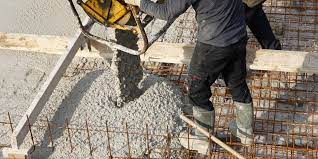Concrete is an immensely versatile material, which is used for everything from construction to art to self-pampering. (If you’re thinking of making your home a “concrete jungle,” we’ve got to tell you that the “concrete jungle” scene in The Jungle Book actually wasn’t filmed with concrete; it was built with adobe.) Concrete is a versatile material that has been used in a variety of ways over the years, and it continues to play an important role in the construction industry.
Depending on the needs, concrete can be used in many different forms, including:
- Stamped concrete
- Poured concrete
- Exposed aggregate concrete
- Color-blended concrete
- Engineered concrete
- Mortar concrete
- Concrete Foamed.
- Concrete countertops
Stamped concrete
Stamped concrete or decorative concrete, as it is sometimes referred to, involves using pigmented concrete to create a design or pattern. It creates a more visually appealing surface than standard concrete and allows homeowners to individualize the look of any outdoor area. You can turn your home’s driveway or sidewalk into a decorative masterpiece, or create a pattern that mimics the look of stone, brick, pavers, or cobblestone.
Poured concrete
Concrete is a versatile material that is used in many ways in construction. It is used in houses, roads, bridges, tunnels, and many other constructions using different materials. When it is used in construction, concrete is made in a mixing truck then poured by a truck, or it can be poured into a mold, or it can be poured on site. Poured concrete is a cement-based mixture that is poured into a form or mold to create whatever shape is desired.
Exposed aggregate concrete
Concrete is a versatile material that is used in many ways in construction. Exposed aggregate concrete is made by adding decorative crushed stone to the concrete mix. Banchakin International Co., Ltd. is a commercial supplier of concrete materials in Thailand. Today, exposed aggregate concrete is widely used for decoration of buildings and roads, like sidewalks, pavements, garden decoration, plazas and streets, and home decoration, such as pool, wall, pavilion and so on.
Color-blended concrete
Concrete is a versatile material that is used in many ways in construction. It is manufactured in different colors and used as the primary material for sidewalks, driveways, patios, and decorative sidewalks and driveways. Color-blended concrete mixes are poured, colored, and cured in a few hours. Color-blended concrete is as durable as traditional concrete, but gives a different aesthetic appearance that is beautiful and unique. The color-blended concrete is easy to maintain, and the material expands and contracts at the same rate as the surrounding areas.
Engineered concrete
Concrete is a versatile material that is used in many ways in construction. Cement – a binding agent – is mixed with water, sand and gravel to form a paste. The paste is poured into molds and allowed to dry before being removed and cured. If the concrete is reinforced with steel, it is known as a reinforced concrete. When concrete is subjected to cold temperatures, it contracts; if the temperature is warm, it expands.
Mortar concrete
Among the construction materials that are most common in Los Angeles, concrete dominates. It’s used in sidewalks, driveways, garages, pools, and countless structures. Although concrete is durable and attractive, concrete mortar is porous. Over time, this can allow water to seep into the underlying ground, causing damage. While fixing the damage from concrete mortar can sometimes be costly and time consuming, there are steps homeowners can take to reduce their risk.
Foamed concrete
Foamed concrete is concrete mixed with foaming agents. The foaming agent used changes depending on the desired properties of the concrete. Foamed concrete is used to decrease density, increase early strength, increase workability, increase the permeability of concrete, increase thermal resistance, and decrease the carbon footprint of concrete. The weight and density of concrete can be reduced by as much as 30 to 40 percent. Foamed concrete presents challenges like increased air voids, decreased compressive strength, decreased drying and curing time, and decreased strength.
Concrete countertops
Concrete countertops are durable and easy to maintain. They are a good choice for a kitchen or bath, and they come in a variety of styles and colors. But are they right for you? Concrete countertops are easy to clean and resistant to stains, but cement countertops can be porous. Concrete countertops are durable, but they require occasional sealing. Concrete countertops are heat resistant, but they won’t stand up to heat from a stove or broiler.
Also related articles https://www.myconcretepolishingtampa.com
